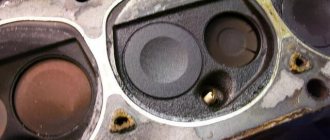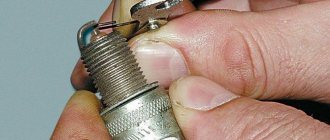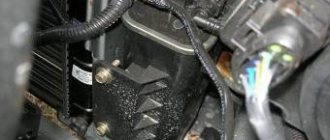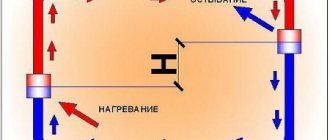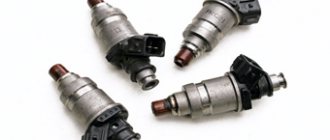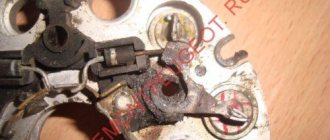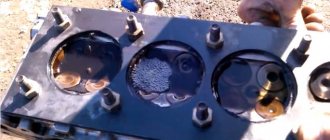Timing valves are located directly in the combustion chamber and are designed for high temperature loads. However, if the normal operation of internal combustion engines is disrupted, even the heat-resistant material from which they are made is destroyed over time. How quickly the valves burn out depends on the nature of the problem. Typical signs that a valve in a cylinder has burned out are rough operation and difficulty starting the engine, as well as loss of power. However, these same symptoms can also occur with other problems. This article will help you understand what a “burnt valve” means, why this happened and learn about ways to diagnose the timing belt without removing the head.
Symptoms of a burnt valve
How can you tell if the valves are burnt out? The easiest way to establish this is by visual inspection, but to do this you would have to remove the cylinder head, which is quite labor-intensive and expensive. Therefore, to begin with, it is worth being guided by indirect signs. Knowing what happens when a valve burns out and how this affects the operation of the internal combustion engine, you can determine the breakdown without disassembling the engine.
How to determine that the valve has burned out, see the table, which shows the characteristic symptoms and main causes.
| Symptom | Causes | Why is this happening |
| Detonation (“knock fingers”) | The octane number does not correspond to that recommended by the manufacturer. Ignition set incorrectly | If gasoline is low-octane or does not ignite at the right time, then when the mixture is strongly compressed, instead of smooth combustion, an explosion occurs. Combustion chamber parts are subject to shock loads, valves overheat and may crack |
| Increased fuel consumption | Incorrect timing operation | The operating mode of the timing belt with a damaged valve is disrupted, power drops, and with it the efficiency of the engine, which can lead to increased consumption |
| Deterioration of traction and dynamics | Decrease in total engine power | A burnt-out valve prevents working compression from being achieved in the cylinder; as a result, the necessary force is not created to move the piston |
| Difficulty starting | The piston speed decreases | The piston is not able to create the necessary force to rotate the crankshaft |
| Shaking and rough idling, change in engine sound | Cylinder misfires | Normally, flashes in the cylinders of an internal combustion engine occur at even intervals (half a turn of the crankshaft for a 4-cylinder internal combustion engine) and with the same force, so the engine rotates evenly. If a valve burns out, the cylinder cannot do its job and the engine is subject to load changes, causing vibration and strong vibrations. |
| Silencer shots | Ignition of VTS in the exhaust manifold | In a leaking cylinder, the air-fuel mixture does not burn completely. As a result, remaining fuel enters the hot exhaust tract and ignites. |
| Popping sounds in the intake | The air-fuel mixture returns to the manifold and receiver | If the intake valve burns out and poisons, then during compression part of the mixture returns to the intake receiver, where it burns when a spark is applied |
The valve has burned out and can no longer provide a seal.
Based on the symptoms listed above, you can find out that the valves in the engine are burnt out. A combination of several signs indicates this with a higher probability. The seat, to which the valve must fit tightly when closing, can also burn out, although this is a less common failure.
If the symptoms indicate the presence of cracks in the valve or that the valve seats are burnt out, the cause of the failure can only be reliably determined through complete diagnostics and troubleshooting. To carry out repairs, in any case, you will have to remove the cylinder head and then replace the failed parts.
Cost to fix the problem
You can replace a valve on a domestic car with your own hands at minimal cost, spending about 1,000 rubles on the valve itself, a new cylinder head gasket, lapping paste, and antifreeze for topping up. But usually it doesn’t end with just one burnout: it may be necessary to mill or replace a cylinder head deformed due to overheating, as well as grooving the valve seats. A pinched valve causes the camshaft cam to wear out.
Service stations are reluctant to change one valve, and full maintenance and repair of the cylinder head starts from 5-10 thousand rubles for a VAZ - up to tens of thousands for modern foreign cars.
After replacing burnt valves and repairing the cylinder head, it is important to eliminate the root cause of the burnout. If this is not done, the part will soon fail again!
How much does it cost to fix the problem?
The price of a burnout repair service greatly depends on the make and model of the car, the cause of the failure, the consequences that have already occurred, as well as the general condition of the engine.
You will need to remove the block head and reassemble it, replacing the valves, possibly their seats and guides, oil seals and grinding the discs into the sockets. In simple cases, you can spend approximately 6,000 rubles, but this figure does not carry any useful information.
The fact is that when opening any engine, a lot of problems with very time-consuming solutions can be revealed. Weakened and torn threads, broken geometry of the joint between the head and the block, defective hydraulic compensators and much more.
Why do engine valves burn out?
What causes a valve to burn out in an engine? The main reason is a violation of the temperature regime in the combustion chamber . As a result, the part is overheated, the metal begins to melt, or, on the contrary, becomes more brittle, crumbles and cracks. Even a small valve defect gradually progresses, causing it to become unusable over time.
There are 6 main reasons why valves on a car burn out:
- Poor mixture . A lean air-fuel mixture burns slower than normal (stoichiometric), part of it burns out already at the exit from the combustion chamber, so the thermal load on the exhaust tract increases. The reasons why the exhaust valve burns out usually lie in a lean mixture or in the following problem.
- Incorrect ignition timing . The higher the octane number of the fuel, the more evenly and slowly it burns, therefore, as the octane rating increases, an increase in the ignition timing is also required. With late ignition, the mixture burns out already in the exhaust tract, overheating the valves. When fuel is too early, gasoline ignites prematurely, causing shock loads and overheating.
- Carbon deposits . At the moment of closing, the valve fits tightly to the seat, which participates in the removal of excess heat. When carbon deposits form on their surface, heat transfer deteriorates significantly. Cooling through the neck alone is not as effective. In addition, the layer prevents the valves from closing completely, resulting in a breakthrough of the burning mixture into the intake or exhaust manifold, aggravating overheating.
- Incorrect valve clearances . On a cold engine, there is a gap between the valve tappet and the camshaft eccentric, which is a reserve for metal expansion. It can be periodically adjusted manually using washers or cups of the required thickness or automatically using hydraulic compensators. If the hydraulic compensator is incorrectly adjusted or worn, the part is in the wrong position. When the valve is pinched, it cannot close completely, the burning mixture breaks into the gap between it and the seat, causing them to overheat. If the intake valve is burnt out, the reasons for this most often lie precisely in pinching or in deposits on its surface that prevent it from closing.
- Problems with the cooling system . If the circulation of coolant in the cylinder head is disrupted or the antifreeze simply cannot cope with heat removal, as a result, the head parts overheat, and the valves and their seats may burn out.
- Incorrect diesel fuel dosage . On diesel engines, valve burnout occurs due to the same excessive thermal loads caused by incorrect dosage of fuel. They may be caused by improper operation of the injection pump or fuel injectors.
Burnt out exhaust valve
Carbon deposits on valves and seats lead to burnout
From the above, we can conclude which valves burn out more often - exhaust valves. Firstly, they are smaller in size and therefore heat up faster. Secondly, it is through them that hot exhaust gases are removed. The intake valves are constantly cooled by the air-fuel mixture or clean air (on engines with direct injection) and therefore experience less thermal stress.
What causes valves to burn out on a gasoline engine?
The answer to the question “why did the exhaust valve burn out on a gasoline engine?” can be found in the previous section in paragraphs 1–5 (mixture, ignition, carbon deposits, clearances and cooling). In this case, the fourth reason applies most to engines that provide manual adjustment of the thermal gap. Do valves with hydraulic compensators burn out? This also happens, but most often for reasons beyond the control of automatic compensators - they themselves rarely fail.
The most common reason why a valve burns out in a VAZ engine with an 8-valve timing belt is precisely untimely or unqualified adjustment of the gaps. On older engines installed in the VAZ 2108 and VAZ 2111, the problem appears more often due to the smaller adjustment interval. On the 1186 series internal combustion engines installed in Kalina, Granta and Datsun, where the interval is increased due to the refinement of the ShPG, it is slightly less pronounced. However, valve pinching is one of the main reasons why an intake valve burns out. And this applies not only to VAZs.
The fact is that due to the subsidence of the seats and the gradual self-grinding of the valves, which rotate freely around their axis, they gradually rise upward. As a result, the gap between the pusher and the eccentric cam of the camshaft decreases, and the adjustment gets lost.
A lean mixture, which causes overheating of the exhaust channel, is the main cause of burnout on gasoline engines with hydraulic valves. But incorrect ignition and cylinder head overheating are equally common on all engines, regardless of the valve adjustment mechanism.
Why do the valves burn after installing HBO?
The main reason why valves burn out on gas is the incorrect setting of the engine for LPG . Gaseous fuel differs from gasoline in octane number: for propane-butane the octane number is usually 100 units, and for methane it is 110. The higher the octane number, the smoother it burns, the longer it takes to reach the “peak” of combustion, so it should be ignited earlier. If 92 or 95 gasoline burn out already in the exhaust tract .
When installing LPG (especially methane), be sure to install a CVT in order to adjust the moment of sparking when driving on gas! Or install dual-mode gas-gasoline firmware. On cars that initially came with LPG (like Lada Vesta CNG), such firmware is installed from the factory; for other models, similar software is created by chip tuning specialists.
The second common reason why valves burn out from gas is running on a lean mixture . A lean mixture is less flammable, burns longer and burns out in the exhaust channel, thereby exposing the valve and its seat to overheating.
Any HBO needs configuration. On systems of the 1st–3rd generation, it is important to correctly adjust the gearbox , and on the 4th and newer systems, set the injection corrections relative to gasoline in the gas ECU. If you adjust the system incorrectly or consciously “strangle” it for the sake of saving, this is fraught with burnout.
Gas consumption on a modern engine cannot be 1:1 to gasoline. Their calorific value is comparable (within 40–45 kJ/g), but the density of propane-butane is 15–25% lower (500–600 g/l versus 700–800 g/l). Therefore, gas consumption on a normally enriched mixture should be greater than gasoline!
As with gasoline, common causes of valve burnout in an engine with LPG can be improper adjustment of clearances, carbon coking and cooling problems. Therefore, when troubleshooting a motor with a burnt-out valve, you should make sure that these problems do not exist.
On engines with manually adjusted valves running on gas, when adjusting the clearances, it is worth making an adjustment of +0.05 mm. For example, for 8-valve VAZ engines, normal intake clearances are 0.15–0.25 mm, and exhaust clearances are 0.3–0.4 mm, but on gas they should be shifted to 0.2–0.3 mm for intake and 0.35–0.45 mm for release.
Why do diesel valves burn out?
The reasons why valves burn out on diesel engines differ from those on gasoline internal combustion engines. They do not have spark ignition, and a lean mixture is a sign of normal operation, since air must always be supplied in excess for complete combustion of diesel fuel. Typical reasons why valves burn out on a car with a diesel engine are:
- too early fuel injection into the cylinders;
- over-enrichment of the mixture due to excessive pressure of the injection pump or overflow nozzles;
- incorrect adjustment of thermal clearances or malfunction of hydraulic compensators;
- overheating of the cylinder head due to impaired circulation of antifreeze or deterioration of its properties.
Most often, a valve on a diesel engine burns out precisely because of the above reasons. On older internal combustion engines with a mechanical injection pump, early injection may occur due to a breakdown of the timer (advance machine) of the pump that controls the timing of the fuel supply. In modern internal combustion engines with a Common Rail system, the culprit for valve burnout may be sensors that incorrectly determine the moment for injection, and worn-out injectors that pour fuel in excess of normal.
The reasons why valves burn out in a diesel car engine may be problems with the air filter and intercooler (on a turbodiesel). A clogged filter restricts the air flow, which is why there is a relatively large amount of fuel at a constant supply volume. An intercooler that overheats (for example, due to contamination) acts in a similar way. It cannot cool the air normally; as a result, although it develops the required pressure in the inlet due to expansion when heated, the amount of oxygen in it ultimately turns out to be insufficient, since the air mass is deficient relative to the norm. Both factors cause over-richness of the mixture, which on a diesel engine can lead to valve burnout.
Auto Novichok - a blog for novice car enthusiasts
If you want to give another person the opportunity to use your car, it would be correct to formalize this decision. For this, various powers of attorney are used, of which the maximum powers are given by a general power of attorney for a car. It allows the person who is included in it to do very much with the vehicle [...] A car today, although it has ceased to be a luxury item, still continues to be classified as a very expensive purchase. It is not surprising that owners are worried about their property and want to protect themselves from unexpected expenses resulting from theft or damage to the vehicle. In this article we will tell […] The presence of toll roads still gives rise to controversy, but this does not change the situation. There are enough sections of roads in Russia where you have to pay to travel. Modern technologies can simplify this process. Like NFC chips in phones and smart watches, a small box is also installed in a car, which [...] Air conditioning in a car is not so much a luxury as a means of ensuring comfortable driving conditions. This is a system of several main components that regulates the temperature and humidity in the cabin. The operation of a car air conditioner is based on the same principles as the operation of a household air conditioner. Naturally, cars of various classes and […] The offset of an ET wheel rim is one of its main geometric characteristics, on which the very possibility of installing certain rims on a car depends. It reflects not only and not so much how much the wheel will protrude beyond the body, although this is how the meaning is understood [...] When a diesel engine operates, a large volume of substances harmful to humans and other living organisms is formed. This includes carbon monoxide, lead compounds, and many other compounds. Particularly dangerous is nitrogen dioxide, which is formed as a result of the reaction of oxygen and nitrogen in the air under conditions of extremely high temperatures. […] More and more car enthusiasts are looking at “mechanics” with contempt. Of course, the need to constantly pull the gearshift lever and periodically squeeze the clutch becomes tiresome over time. Therefore, the number of drivers switching to cars with automatic transmission is growing from year to year. However, this also has its own peculiarities of driving, now [...] Any design of an internal combustion engine requires the presence of spark plugs. They ignite the combustible mixture, thanks to which the engine sets the car in motion. But due to a number of factors, including the formation of soot, over time the candles gradually fail and cease to perform their functions. Let's look at [...] Vehicles include a large number of elements that ensure full operation. Needless to say, among such systems there are no insignificant ones. Especially when it comes to the braking system, which directly ensures driver safety. The main brake cylinder can easily be called a key part in the brake hydraulic drive circuit. That's why […]
How to determine a burnt valve without removing the cylinder head
Inspection of valves using an endoscope connected to a smartphone
There are two main ways to determine a burnt-out valve with high accuracy without disassembling the engine:
- compression measurement;
- visual inspection with an endoscope.
To understand that the valves have burned out, you can carry out these operations yourself or contact a car repair shop. A budget endoscope, like a compression meter, will cost 500–1000 rubles. The mechanics at the service station will charge about the same for diagnostics. Inspection with an endoscope connected to a smartphone, tablet or laptop allows you to get a good look at the damaged valve, and a “compressometer” will show the pressure drop in the cylinder.
Before checking a burnt valve, you need to make sure there are no problems with clearances. They must be set correctly, because a pinched valve that is still intact and cannot close completely behaves in the same way as a valve that has already burned out.
To measure compression, especially on engines with an electronic throttle, you need an assistant, because at the time of testing the throttle must be fully open. The assistant will also start the starter.
How to find a bad cylinder
You can determine a cylinder with a burnt-out valve by measuring compression or removing wires/coils from spark plugs with the engine running. How to check a burnt valve on a gasoline engine by sound:
Determination of a cylinder with a burnt-out valve
- Start the engine, let it warm up and open the hood.
- Remove the wire or coil from the spark plug of the 1st cylinder.
- Listen to whether the sound of the engine has changed or whether the vibrations have increased.
- Return the wire or coil to its place, listen again for changes in operation.
- Repeat steps 2–4 for the remaining cylinders.
If the cylinder maintains pressure properly, then when it is turned off, the engine begins to work worse, trip and shake, and when connected, operation returns to normal. But if the valve burns out, the cylinder does not fully participate in the work, so the sound and vibration of the motor do not change after disconnecting and connecting the spark plug.
For diesel engines, only the option with a compression gauge is available due to the lack of spark plugs. In a cylinder with a defective valve, the pressure will be approximately 3 (or more) atm less than in the rest .
How to determine what the problem is
Since you can definitely recognize a burnt valve with an endoscope, it is better to choose this option if possible. For inspection you need:
Burnt valve in the endoscope picture
- Connect the “endoscope” to your laptop or smartphone and display the image on the screen.
- Place the mirror attachment on the camera (not necessary if the “endoscope” has a controlled head).
- Unscrew the spark plug and place the “endoscope” into the cylinder through the hole.
- Inspect the valves for defects.
- Repeat steps 3–4 for each cylinder.
Testing with a compression gauge is based on understanding what happens to the pressure when a valve burns out. For a heated gasoline internal combustion engine, normal compression is 10–15 bar or atmospheres (1–1.5 MPa), depending on the compression ratio. The pressure in a diesel cylinder is 20–30 bar or atm. (2–3 MPa) , therefore, to check it you need a device with a pressure gauge that has a wider measurement range.
How to determine that a valve has burned out using a pressure gauge is indicated in the instructions below. If the tip of the compression gauge is equipped with a rubber cone rather than a thread, an assistant will be required.
The procedure for checking burnt-out valves with a compression meter:
- Unscrew the spark plugs (on a gasoline engine), glow plugs or injectors (on a diesel engine) from the cylinder head. To avoid mixing them up during assembly, number the spark plug wire tips or coils.
- Shut off the fuel supply, for example, by turning off the fuel pump (you can remove the fuse) or disconnecting the line from the injection pump.
- Screw the “compression gauge” into the hole of the 1st cylinder or press it tightly with a cone to the hole.
- Ask an assistant to turn the engine with the starter for 5 seconds, while pressing the gas pedal to the floor to properly fill the cylinder with air.
- Record the pressure gauge readings and compare them with the normal values for your engine.
- Reset the “compression gauge” by releasing the pressure from it.
- Repeat steps 3–6 for each of the remaining cylinders.
Gasoline “compression gauge” with thread and conical nozzles
Diesel “compression meter” with a measurement scale of up to 70 bar
After taking compression measurements, compare the instrument readings for each cylinder. Normal values for different internal combustion engines are indicated above; the spread across cylinders should be within 1 bar or atm. (0.1 MPa). A sign of burnout is a significant (3 atm or more) drop in pressure.
A burnt out valve is not always the culprit for low pressure. Poor compression can be caused by stuck, worn or broken rings, excessive cylinder wall wear, or piston damage. You can understand that a burnt valve behaves this way by injecting about 10 ml of engine oil into the cylinder and re-measuring the compression. If it has increased, there is a problem with the rings or cylinder wear; if it has not changed, the valve does not hold pressure due to burnout.
Oil will also not help increase compression if it is not there due to a burnt out or burst piston due to detonation - the symptoms will be the same as with a burnt out valve. You can check the integrity of the piston without disassembling it with an endoscope or by feeling it with a long thin rod through the spark plug well.
Is it possible to drive with burnt out valves?
For those who, based on symptoms, have determined that their car has problems with the valves and are wondering: is it possible to drive if the valve is burnt out? – the immediate answer is: it is extremely undesirable, it can lead to additional costs. If the valve really burns out, the consequences can be disastrous for the engine:
- pieces of a collapsing valve damage the piston and cylinder head, peel off the cylinder walls, and break rings;
- if the intake valve burns out, the air-fuel mixture breaking into the intake receiver can flare up there and tear it (especially important for plastic receivers);
- the burning mixture, breaking through a leaky valve, leads to overheating of the manifold, exhaust pipe, gasket, leading to burnout of exhaust parts;
- a mixture that cannot burn normally in the cylinder burns out in the exhaust, damaging the catalyst and oxygen sensor;
- due to persistent local overheating, the cylinder head may fail, which will require milling during repairs or even replacement.
Consequences
The valve that begins to let gas through will gradually collapse. This can lead to damage to other parts, cylinder walls, piston, rings. Unburned gasoline will lead to damage to the catalyst, and once it gets into the oil, it will greatly change its properties, which can damage the liners and crankshaft.
The engine will vibrate, destroying the attachments and mountings of the power unit. Power will drop, consumption will increase.
Is it possible to drive
Driving with loss of compression is highly undesirable. Timely repairs minimize the consequences, preserving the engine as a whole.
All its parts and systems are firmly connected during operation; a violation of this balance will lead to an avalanche-like increase in destruction. Instead of replacing the valves and eliminating the cause of the burnout, a major engine overhaul will be required.
How to avoid valve burnout
- Monitor the quality of mixture formation by periodically inspecting the spark plugs for carbon deposits. If it is white, the mixture is poor and needs adjustment.
- Observe the frequency of replacement of spark plugs prescribed in the regulations of your car.
- When driving on gas, reduce the interval for measuring valve clearances. Check them every 10 thousand km (at every oil change) and, if necessary, adjust.
- Fuel with the manufacturer's recommended octane rating.
- When driving on gas, use a UOZ variator or dual-mode gas-gasoline ECU firmware.
- Change the oil on time, using products with tolerances recommended by the car manufacturer.
- Change antifreeze every 3 years or after 40–50 thousand km to prevent deterioration of its properties, monitor its level in the tank and the temperature when driving.
- When the “Check Engine” notification appears on the instrument panel, diagnose the engine using OBD-2 to quickly troubleshoot problems.
By adhering to these recommendations, you will extend the life of the engine, since preventing engine valves from burning out is easier and cheaper than replacing them. In the case of a VAZ, there is a chance to inexpensively buy a “live” head at a disassembly site, but even a used part for foreign cars can hit your wallet.
Compression check
Having identified a non-functioning cylinder, we must check the cylinder for leaks. There are several ways to do this:
- measuring compression in the engine. Even the cheapest compression meter with a suitable measurement scale will be suitable for these purposes. The main thing is that there is an adapter with a suitable thread available. Without trusting the accuracy of the device, focus not so much on the number shown, but on the difference between the cylinders. Compression when the valve burns out decreases by 3-6 atm. in comparison with neighboring pots;
When cranking the engine with the starter, the throttle valve must be fully open, the fuel supply to all cylinders must be turned off, and the battery must be fully charged.
- checking the cylinder for leaks using a tester. The device is a gearbox through which compressed air is supplied to the cylinders. A pressure gauge installed nearby measures the actual pressure after the reducer, converting air loss into a percentage leakage rating;
- relative compression measurement. You can’t do such a test yourself, but a diagnostic technician with an oscilloscope will check it in no more than 15 minutes. You can measure relative compression using the starter current or using the CSS script by Andrey Shulgin.
Why change
Failure of cylinder head valves is not uncommon. They can fail in several cases: they can bend when the timing belt breaks. If the timing belt jumps several teeth, which is not uncommon with a poorly tensioned belt, the same thing will happen: the valve stem will bend, the plate will not fit tightly to the seat and the valve will not be able to maintain compression. On a chain drive, a stretched chain often jumps several teeth. the effect is the same: just now the car was driving calmly, and then suddenly it stopped and nothing could be done to help it.
Another indication for replacing valves may be their burnout. This happens when the valve clearance is set incorrectly, namely, the valve is a little “pinched” and does not close completely, which impairs heat dissipation. The exhaust gases do their job and the valve disc burns out. Sometimes the seat has to be replaced along with the valve.
The valves can only be changed with the head removed; there is no other way to remove them.
How will the engine work and what will happen if the valves are clamped?
How to understand that the valve is jammed
If after starting the engine runs normally, but during long operation the thrust drops - this is a symptom of pinched valves. Another sign of jammed valves can be shots into the muffler when releasing gas. Because The combustion chamber is not completely closed, compression decreases and a disruption in the working process occurs. When adjusting, it is better to exceed the permissible gap than to make it smaller.
The consequence of clamped valves is overheating, increased fuel consumption and, as a result, burnout. It is undesirable to operate the engine with a burnt-out valve; this leads to burnout of the valve seat. What the car owner will end up having to do is replace the entire head.
Consequences of valve burnout
Experienced drivers know the answer to the question of whether it is possible to drive with a burnt-out valve. In the most optimal scenario, if you do not pay attention to the problem at first, the main consequence of a burnt-out valve mechanism will be increased fuel consumption as a consequence of a drop in the total engine power due to the inoperability of one of the valves.
If you continue to ignore engine detonation, the valve seat may burn through, which is why replacing the valves will no longer be enough - you will have to change the head as well.
Sometimes, as a result of the valve crumbling, a piece of broken metal ends up in the cylinder. If it is large enough, then there is a high probability that it can damage the piston and even the cylinder walls. In the latter case, the engine must be completely replaced.
If you have a gas system, the valve adjustment procedure should be carried out much more often - approximately every 10,000-12,000 kilometers. The reason is the higher temperature characteristics of combustion of the gas-air mixture. The adjustment procedure itself is more complex and responsible. The fact is that the exhaust valves are usually slightly pressed when using gas. It is enough to press them a little more so that the valve begins to jam, and then its burnout is only a matter of time. Gasoline units are safer in this regard.
It is not recommended to lean the gas mixture for the sake of economy - the loss of engine power will force you to press the accelerator pedal with more force than usual, and as a result, the consumption will even increase, and the valves will begin to burn.
But if the adjustment of the fuel assembly supply is carried out correctly, the power of the power unit will be established at a level comparable to the operation of a gasoline engine. Drivers accustomed to driving on gasoline usually make adjustments when detonation noises appear, and this is, in principle, true. But for gas cars, this approach is unacceptable - adjustments should be made without waiting for the compression to decrease; the valve can burn out without the appearance of such symptoms as noise when the engine is running.
Design
1- valve, 2- plate, 3- spring.
The valve is inserted into the cylinder head from below, and a spring is installed on top of it, which presses the valve to the seat. The spring rests against the valve through a plate, which is fixed with crackers. Oil seals are installed between the valve guide and the valve, which retain the oil and prevent it from escaping into the combustion chamber.
The camshaft presses on top of the valve. To get to the valve, the camshaft must be removed. On some engines, the same “classic” Lada, the camshaft is pressed on the valve through rocker arms, they are placed on another shaft. The rocker shaft must be removed to gain access to the valve.
Information for the consumer about preventing the valve grinding operation at the ZZA cylinder head.
When installing ZZA LLC cylinder heads on engines, it is forbidden to spill gasoline and grind the valves. Complete tightness of the combustion chamber is achieved during the running-in process by “tapping” the valves in the first minutes of engine operation.
The seat material used (heat-resistant powder material with a porous structure) and blade processing of the working chamfer with high precision in diameter, angle of inclination and roughness make it possible to eliminate the operation of grinding in the working chamfer of the valves.
During the running-in process, the valves are knocked against the seats and at the same time the tightness of the combustion chamber sharply increases compared to a new (unrun-in) cylinder head.
Carrying out valve lapping on new cylinder heads produced by ZZA LLC using lapping pastes with unknown characteristics does not improve, but rather worsens, the service life of the “valve sleeve-valve-seat” connection for the following reasons:
— the possible introduction of abrasive material into the porous structure of the seats and bushings leads to intensive wear of the surfaces of the valve and seat during operation;
— when lapping paste gets on the valve stem, the surface roughness of the valve stem inevitably deteriorates and the thin carbonitrated layer is destroyed, which is used to increase the hardness of the metal surface and reduce the coefficient of friction in order to increase wear resistance;
— in oil reflector caps the geometry of the working edge is violated, which requires 100% replacement of the caps;
— after the grinding operation, high-temperature washing with water under pressure with special detergent additives and subsequent drying is required, which is usually not used in a car service center.
Valve lapping is used in repair technologies for cast iron seats with high hardness (over 55 HRC), and for powder seats (hardness 35-40 HRC), it is necessary to use a special cutter based on the hole in the bushing for the valve stem.
Hi all! Let's talk today about such a holivar issue as grinding valves. The procedure in the vast expanses of Drive 2 is, to put it mildly, popular - I have not yet seen a single description of a major overhaul of an internal combustion engine that did not mention this “ritual”! Moreover, we will rather not even talk about the rubbing itself, but about those things that cause its need.
First, let's look at how the valve-seat assembly works in geometric terms:
We see a bunch of chamfers (and the saddle may not have a chamfer, but a radius)
Barik-CZ wrote a lot about the geometry of the seat and its influence on the operation of the internal combustion engine, but I want to draw attention to several key points for the life of the cylinder head: 1. The valve is pulled to the seat using a return spring
2. The ratio of the valve pressing force to the area of the chamfer on the seat gives the specific pressure of the valve on the seat. 3. The valve is cooled through the chamfer on the seat.
As you can see, all the key moments for the operation of the cylinder head rest on two chamfers - on the valve plate and on the seat.
What happens if the chamfer on the saddle is uneven? The specific pressure at different points of the seat will be different; in the zone with maximum pressure, wear will be significantly faster than in neighboring ones. As a consequence, a violation of the tightness, a breakthrough of hot gases with a simultaneous sharp increase in the temperature of the valve in the zone of gas breakthrough and almost zero cooling in it. The result is valve burnout.
Causes
There are several reasons why valves can burn out:
- Manufacturing defects. The likelihood of deviations from the norm during the production of components is small, but still exists. Heterogeneity of the metal, defects in welding seams, microcracks are the first signs of defects.
- Critical temperatures. The operating temperature of the valves fluctuates around 650 °C. If the heat dissipation system is faulty, excessive overheating will cause the metal to quickly deteriorate.
- Poor quality gasoline. A lean fuel mixture leads to temperature spikes, which is even more damaging to the valves.
- Gas. Gas-powered engines are subject to greater loads than gasoline engines. Especially if the car is set to low gas supply. It is recommended to calibrate the valves every 10 - 15 thousand km.
Signs
The symptoms of a burnt valve coincide one-to-one with a sign of a malfunction in the ignition system. Therefore, very often inexperienced mechanics begin to repair the ignition. At the same time, they change the distributor cap, install new high-voltage wires, spark plugs, and turn on the ignition, but there is no result. The engine has been running every now and then and continues to do so. They, cursing the creators of cars, continue to look for the cause, without even realizing the true cause of the problem. Moreover, even those who guessed that the problem lies in the engine will only find out about the burnt-out valves after removing the cylinder head.
However, there is a way to diagnose this malfunction without disassembling the engine. The search for the cause must occur according to a certain algorithm:
- Ignition is checked
. Here you need to pay attention to the performance of the distributor, the correct ignition timing, and the integrity of the wires; - Identify the problem cylinder. They do this in the following way. One by one, they pull off the high-voltage caps from the spark plugs. If the cylinder is working, the engine will start to stall. The faulty one will not respond to such an action, and the operation of the engine will not change. This should be done carefully. The caps must be removed using insulated pliers;
- After this, compression is measured. Most likely, it will be slightly lower than the required 11 points. But this may be an indicator of both problems with the valves and a malfunction of the piston group.
Video.
Valves ensure the implementation of working processes in the cylinder. The intake valves are responsible for supplying a portion of the fuel-air mixture, and the exhaust valves are responsible for releasing combustion products. Burnout of one valve has a detrimental effect on the operation of the entire cylinder.
What does a burnt valve look like?
Signs of a burnt-out valve include engine shaking, smoke from the breather (the breather is a valve for venting the crankcase and releasing excess pressure) and, when the engine operates for a long time with a burnt-out valve, increased fuel consumption. Let us explain the popular concept of “motor troit”. This means a malfunction of one cylinder, which manifests itself in a loss of power and throttle response, vibration and shots in the exhaust pipe. But these signs of a burnt out valve are ambiguous.
The engine can also stall due to broken spark plugs or a weak spark.
Smoke from the breather can also occur if the piston is damaged. But there is a distinctive feature here - the color of the smoke should be bluish, and the spark plug should be covered with oil, which is associated with a broken piston. In case of burnout, the spark plug remains dry. Note that a burnt valve in a carburetor engine and in an injector gives the same symptoms, because The only difference is the fuel injection system.
